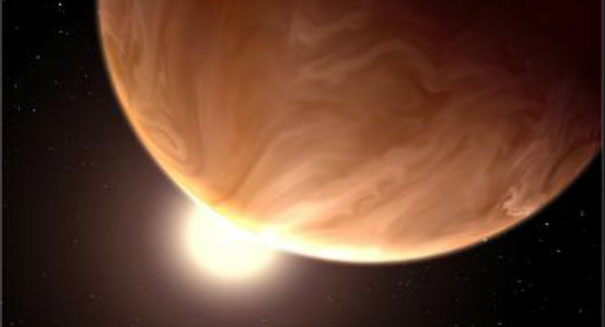
Weather characterizations are the first of their kind for a planet outside our Solar System
Weather forecasters have a tough job. For one thing, for all of the high-tech gadgetry they employ, their accuracy is spotty at best. They get no credit if they’re right about the weather being nice, because people only care about foul weather. If they’re wrong, the public is unpleasantly surprised. If they’re right, well, the public is just unpleasant. The gig is easier for scientists forecasting the weather on planet GJ1214b: Clouds, followed by more clouds, and a temperature of a balmy 450 degrees Fahrenheit.
The researchers, operating out of the University of Chicago, report that this is the first time anyone’s ever definitively characterized the atmospheric conditions of a super-Earth class planet orbiting a star other than the sun. Using the Hubble Space Telescope, a team of astronomers led by UChicago’s Laura Kreidberg and Jacob Bean have detected clear evidence of clouds in the atmosphere of GJ 1214b.
GJ1214b is known as a super-Earth type planet because its mass is intermediate between those of Earth and Neptune. Recent searches for planets around other stars (“exoplanets”) have shown that super-Earths like GJ 1214b are among the most common type of planets in the Milky Way galaxy. Because no such planets exist in our Solar System, the physical nature of super-Earths is largely unknown. That is, calling it a “super-Earth” does not imply it has the capability to sustain life.
That said, the work being done represents an important milestone in searching for Earth-like planets elsewhere in the galaxy.
“We really pushed the limits of what is possible with Hubble to make this measurement,” said Kreidberg, a third-year graduate student and first author of the new paper. “This advance lays the foundation for characterizing other Earths with similar techniques.”
“I think it’s very exciting that we can use a telescope like Hubble that was never designed with this in mind, do these kinds of observations with such exquisite precision, and really nail down some property of a small planet orbiting a distant star,” explained Bean, an assistant professor and the project’s principal investigator.
GJ1214b, first discovered in 2009 by the MEarth Project, was originally believed to have an atmosphere that was either predominantly water vapor or hydrogen-dominated with high-altitude clouds. When observed through the Hubble, it was revealed that there were no chemical fingerprints in the planet’s atmosphere. This allowed the astronomers to rule out cloud-free atmospheres made of water vapor, methane, nitrogen, carbon monoxide, or carbon dioxide.
Because the super-Earth is located “just” 40 light years away from our own, non-super Earth, it’s the most easily observed planet of its kind. Scientists get the opportunity to study its atmosphere every 38 hours, when it passes in front of its red dwarf parent star.
Leave a Reply